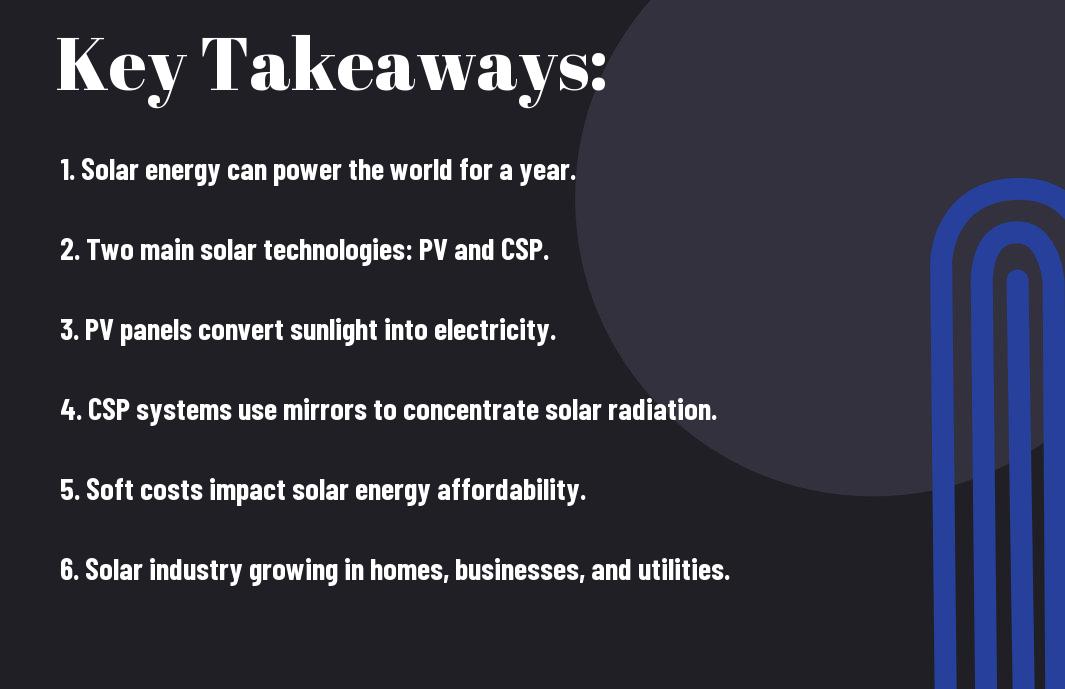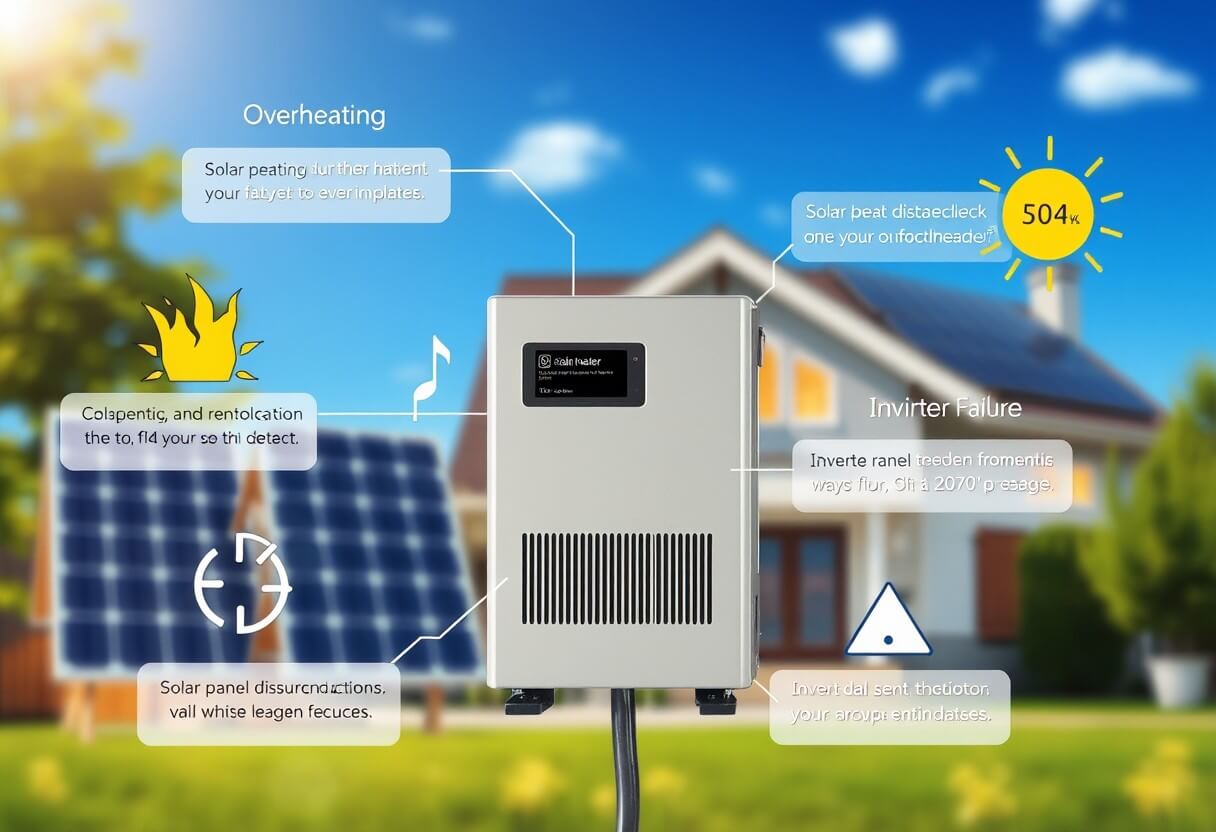Most people are aware of the sun’s ability to provide light and warmth, but did you know that it also holds the key to powering our world? In this blog post, we will probe into the fascinating world of solar energy technology and how it harnesses the sun’s rays to generate electricity. From photovoltaic panels to concentrating solar-thermal power systems, we will explore the different methods used to convert sunlight into usable energy. Join us as we uncover the basics of solar radiation, the workings of PV and CSP systems, and the integration of solar energy into our daily lives and electrical grids. Let’s unlock the potential of the sun and discover how solar energy is shaping the future of sustainable power.
Key Takeaways:
- Solar Radiation: Sunlight is a powerful source of energy, and technologies like photovoltaic panels and concentrating solar-thermal power systems harness this radiation to generate electricity or store it for later use.
- Types of Solar Technologies: There are two main types of solar energy technologies – photovoltaics (PV) and concentrating solar-thermal power (CSP). PV panels convert sunlight directly into electricity, while CSP systems use mirrors to concentrate solar radiation for electricity production.
- Integration and Soft Costs: It’s not just about generating electricity – solar energy systems need to be integrated into existing grids and buildings. Additionally, soft costs such as permitting, financing, and installation play a significant role in the overall cost of implementing solar energy solutions.
Solar Energy 101
The Nature of Solar Energy
For centuries, the sun has been the primary source of energy for life on Earth. Solar radiation, emitted by the sun in the form of light, is a powerful and abundant resource that can be harnessed to generate electricity. Every hour and a half, the amount of sunlight that reaches the Earth’s surface is enough to meet the world’s energy needs for an entire year.
Benefits of Harnessing Solar Power
Any discussion on solar energy is incomplete without highlighting its numerous benefits. Solar power not only reduces electricity costs but also contributes to a more resilient electrical grid, creates job opportunities, and promotes economic growth. Furthermore, when paired with storage solutions, solar energy can provide backup power during nighttime or outages, ensuring continuity of important services.
The utilization of solar energy not only offers environmental benefits by reducing carbon emissions but also has a significant impact on lowering electricity bills for consumers. According to the U.S. Department of Energy, solar energy systems can operate efficiently on both small and large scales, making them a versatile and sustainable energy solution for a variety of applications.
Photovoltaics Basics
How Photovoltaic Cells Convert Sunlight into Electricity
One of the key components of solar energy technology is photovoltaic (PV) cells, which are commonly found in solar panels. When sunlight hits these cells, the energy from the sunlight is absorbed, creating electrical charges within the cell. These charges then flow, generating electricity that can be used to power various devices or stored for later use.
Types of Photovoltaic Systems
For those looking to harness solar energy, there are two main types of photovoltaic systems available: grid-tied systems and off-grid systems. Grid-tied systems are connected to the main electrical grid, allowing excess energy to be fed back into the grid. On the other hand, off-grid systems operate independently of the grid, storing excess energy in batteries for later use. Though the types differ in connectivity, both systems offer sustainable ways to utilize solar power.
| Grid-Tied Systems | Off-Grid Systems |
|---|---|
| Connected to the main grid | Operate independently |
| Excess energy can be fed back | Store excess energy in batteries |
| Increased grid reliability | Energy independence |
| Lower upfront costs | No reliance on external sources |
| Less maintenance required | Suitable for remote locations |
Photovoltaic systems offer a sustainable and efficient way to harness solar energy for a variety of applications. Whether utilizing grid-tied systems for increased grid reliability or opting for off-grid systems for energy independence, both options provide a valuable source of renewable energy. Through the use of photovoltaic technology, individuals and businesses can contribute to a greener future while benefitting from lower energy costs and reduced reliance on traditional power sources.
Concentrating Solar-Thermal Power Basics
Despite the widespread use of photovoltaic technology, concentrating solar-thermal power (CSP) remains a powerful contender in the solar energy sector. For a comprehensive understanding of how CSP works, refer to Unlocking the Power of the Sun: A Comprehensive Guide to Understanding Solar Energy.
The Concept of Concentrating Solar-Thermal Power (CSP)
SolarThermal power plants utilize mirrors to concentrate sunlight onto receivers that collect and convert solar energy into heat. This heat can then be used to generate electricity or stored for later use. The efficacy of CSP technology lies in its ability to harness the power of the sun and convert it into a reliable source of renewable energy.
The Various Technologies and Their Applications
Powering large-scale installations, concentrating solar-thermal power technologies have proven to be instrumental in generating clean energy for electricity grids. With advancements in thermal energy storage, CSP systems can provide round-the-clock power generation, making them a valuable asset in the transition towards sustainable energy sources. By leveraging the heat of the sun, CSP technologies offer a reliable and efficient solution for meeting the world’s energy demands.
Systems Integration Basics
Keep Solar Energy: Guide to unlock the Power of Sun: in mind while delving into the world of solar energy systems integration. This crucial aspect involves seamlessly incorporating solar technologies into existing electrical grids and structures to maximize efficiency and effectiveness.
Challenges in Integrating Solar Energy into the Grid
Challenges arise when integrating solar energy into the grid due to the fluctuating nature of solar power generation. Managing grid stability, ensuring compatibility with existing infrastructures, and balancing supply and demand are ongoing complexities. Additionally, the varying levels of solar energy production can pose challenges in maintaining a consistent power supply to meet the needs of consumers.
Innovations in Solar Energy Systems Integration
On the flip side, continuous advancements in solar energy systems integration are shaping a more sustainable future. Innovations in smart grid technologies, energy storage solutions, and grid modernization strategies are revolutionizing how solar power is seamlessly integrated into the grid. These innovations are paving the way for a more reliable, resilient, and efficient energy system that harnesses the power of the sun to meet our growing energy demands.
Plus, the integration of solar energy systems with other renewable sources and traditional energy grids is enhancing the overall reliability and stability of the grid. By combining solar power with innovative energy management techniques and grid optimization strategies, we are moving towards a more interconnected and sustainable energy landscape that benefits both the environment and society as a whole.
Soft Costs Basics
Understanding the Non-Hardware Costs of Solar Installations
Many factors contribute to the overall cost of solar energy installations beyond just the hardware. These non-hardware costs, also known as soft costs, include permitting, financing, installation, customer acquisition, supplier payments, and operational expenses. In fact, soft costs make up the largest share of the total costs for rooftop solar energy systems, impacting the affordability and accessibility of solar energy for consumers.
Strategies to Reduce Soft Costs in Solar Projects
With the understanding that soft costs play a significant role in the overall cost of solar energy installations, implementing effective strategies to reduce these costs is crucial. Solar companies can streamline permitting processes, optimize financing options, utilize standardized installation practices, and invest in customer education to lower soft costs. By addressing these non-hardware expenses, the solar industry can make solar energy more cost-effective and competitive in the energy market.
Going Solar Basics
Assessing Solar Potential and Site Selection
Not all locations receive the same amount of sunlight, so it’s crucial to assess the solar potential of your site before going solar. Factors such as shading, orientation, and roof condition can impact the efficiency of solar panels. Consulting with a solar energy provider can help determine the best location for solar installation based on your specific site’s characteristics.
Steps for Homeowners and Businesses to Adopt Solar Energy
Solar energy can help reduce electricity costs, contribute to a resilient grid, create jobs, and operate efficiently on both small and large scales. For instance, a residential rooftop solar system can not only generate electricity for your home but also provide backup power during outages. Businesses can benefit from installing solar panels to lower operational expenses and demonstrate a commitment to sustainability. Taking these steps towards adopting solar energy can have a significant positive impact on both the environment and your bottom line.
Solar Industry Basics
Market Trends and Growth in the Solar Industry
On the forefront of renewable energy solutions, the solar industry is experiencing rapid growth and significant market trends. The amount of sunlight that strikes the earth’s surface in an hour and a half is enough to handle the entire world’s energy consumption for a full year. Residential systems, businesses, and utility-scale solar power plants are all contributing to the expansion of solar energy generation.
Job Opportunities and Economic Impacts of Solar Expansion
Trends indicate a surge in job opportunities and positive economic impacts accompanying the expansion of solar energy. This sector not only helps reduce the cost of electricity but also creates jobs, spurs economic growth, and contributes to a resilient electrical grid. Soft costs, such as permitting and financing, play a significant role in the total costs associated with solar energy systems, making it a vital industry for job creation and economic development.
Dive Deeper
Once again, for a deeper understanding of the innovative research and development happening in the field of solar energy, check out the article “Unlocking the Power of Solar Energy: A Sustainable Journey”.
Advanced Solar Technologies and Research
Any advanced research in the field of solar energy focuses on pushing the boundaries of current technologies and exploring new possibilities. Below is a breakdown of some key areas in advanced solar technologies and research:
| Solar Panel Efficiency Innovations | Research into improving the efficiency of solar panels to capture more sunlight and convert it into electricity. |
| Battery Storage Solutions | Exploration of advanced battery technologies to store excess solar energy for later use during nighttime or grid outages. |
| Smart Grid Integration | Integration of solar energy systems with smart grid technologies for better energy management and distribution. |
Global Solar Energy Policies and their Impact
Advanced global solar energy policies play a crucial role in shaping the adoption and growth of solar energy on a worldwide scale. Understanding the impact of these policies is vital for driving sustainable energy transitions and combating climate change.
Global initiatives such as incentives for solar installations, feed-in tariffs, and renewable energy targets are key components of effective solar energy policies. By implementing supportive policies, governments can drive investment in solar technologies, create jobs, and reduce greenhouse gas emissions.
Conclusion
Considering all points discussed, it is clear that solar energy has the potential to revolutionize the way we power our world. With the abundance of sunlight available to us, harnessing solar energy through photovoltaic panels and concentrating solar-thermal power systems offers a sustainable and renewable solution to our energy needs. By delving into the basics of solar radiation, PV and CSP technologies, systems integration, soft costs, going solar, and the solar industry as a whole, we can unlock the full potential of the sun’s power. The innovative research being conducted by the U.S. Department of Energy’s Solar Energy Technologies Office further drives advancements in this field, paving the way for a cleaner, more efficient energy future. Embracing solar energy not only benefits the environment but also contributes to economic growth, job creation, and energy independence. It’s time to fully harness the power of the sun and embrace the possibilities of solar energy.
FAQ
Q: What is solar energy?
A: Solar energy is sunlight that is converted into usable energy through technologies like photovoltaic panels or concentrating solar-thermal power systems.
Q: How do photovoltaic (PV) panels work?
A: PV panels absorb sunlight, generating electrical charges that produce electricity when sunlight hits them. This electricity can be used immediately or stored for later use.
Q: What are soft costs in the solar energy industry?
A: Soft costs in solar energy refer to non-hardware expenses like permitting, financing, installation, and customer acquisition. These costs can impact the overall cost of solar energy systems significantly.





